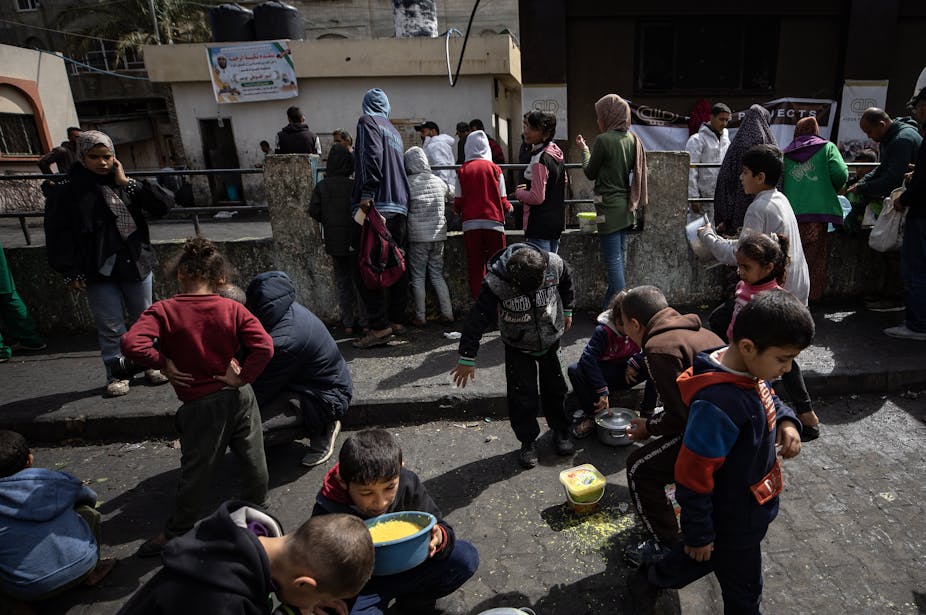Some are calling it the “flour massacre”. At dawn on the morning of February 29, as a convoy of about 30 trucks carrying aid moved along the coast road in Gaza City, it was mobbed by crowds of Palestinians desperate to get their hands on food to feed their families.
Like just about everything else in this devastating conflict, there are two distinctly different versions of what happened next. Israeli authorities said people were killed when the crowd ran out of control, with some being run over by aid trucks and others crushed by the desperate crowd. Palestinian eyewitnesses say that Israeli Defense Forces personnel opened fire on the crowd.
Whatever the truth, the episode left 112 Palestinians dead and 750 more were injured.
But, as the two sides wrangle over this, and the toll from Israel’s assault on the Gaza Strip grows ever higher, deaths from hunger and thirst are beginning to mount. The UN, World Food Programme and agencies on the ground in Gaza say 15 children have already died of malnutrition and dehydration in Gaza and that this could be the tip of a considerable iceberg, with the prospect of famine in the Gaza Strip by May.
But as Leïla Choukroune, an expert in international law at the University of Portsmouth, notes, there is a considerable body of law prohibiting the use of starvation as a weapon of war. The truly awful thing is that conflicts like the one in Gaza, and others in Sudan, Syria, Yemen, Myanmar and Haiti, means that there are hundreds of millions of people living in danger of starvation.
As the UN rapporteur on the right to food Michael Fakhri noted in 2022, “conflict and violence were the primary causes of hunger, malnutrition, and famine”. It wasn’t just “because there was not enough food to go around”.
Read more: Gaza conflict: rising death toll from hunger a stark reminder of starvation as a weapon of war
Another age-old weapon in the aggressor’s armoury is the deliberate use of sexual violence, which dehumanises the civilian population, humiliates victims and creates fear in local communities where it is committed. It’s a particularly pernicious crime with lasting effects. The offspring of women raped in war are often discriminated against by their communities as they grow up.
The United Nations recently said it had found reasonable grounds to believe that Hamas fighters and others engaged in the attacks committed crimes of sexual violence including rape and gang rape. On the other side of the conflict, Palestinians being released from Israeli custody report having been subjected to sexual violence and humiliation at the hands of their captors.

Gaza Update is available as a fortnightly email newsletter. Click here to get our updates directly in your inbox.
Rossella Pulvirenti, a researcher in human rights law from the University of Nottingham, writes that while rape and sexual violence in conflict have been going on as long as war itself, they have been distressingly widespread in recent decades. But it wasn’t until the 1990s, after the conflicts in the former Yugoslavia and Rwanda, that the international community condemned the use of sexual violence as a weapon of war.
Pulvirenti says that while there is a host of international law dealing with the crime of sexual violence in warfare, it’s extremely difficult to investigate and prosecute. For a start, Gaza is not a safe place for investigators to track down victims and witnesses who – in any case – may be unwilling to testify due to fear, trauma or shame.
But as she concludes: “Ensuring accountability for these crimes will be vital to break the cycle of impunity in the interests of reconciliation and a long-term sustainable peace.”
Hard road to peace
But a long-term, sustainable peace looks a long way off, despite Joe Biden’s optimistic predictions a week or so ago that a ceasefire deal was looking close. Frankly, the convoy deaths mentioned earlier will not have made negotiators lives any easier. But the fact that Israel declined to send a delegation to Cairo for talks, while Hamas continues to stonewall over the number and names of the October 7 hostages it is still holding says a lot about the complete lack of faith on either side of this conflict.
John Strawson is a Middle East expert at the University of East London who has written for us many times about Israeli politics. We put a number of questions to him about the progress of the peace talks, the Israeli president Benjamin Netanyahu’s vision for post-conflict Gaza as well as what the broader Israeli population wants and the extent to which US and other international pressure might bring the warring parties together. It’s a valuable, broad-ranging and insightful discussion.
As noted here earlier, the fate of the Israeli hostages still being held in Gaza will be one of the key issues in any ceasefire deal. It seems certain that any deal will involve a hostage-prisoner swap like the ones that have already seen the release of 112 live hostages. Hamas is believed to still be holding about 130, and the clamour among the Israeli people for their release is passionate, unrelenting and, it would appear, more important to many Israelis than any other outcome from Netanyahu’s offensive in Gaza.

But for Palestinians, the release of hundreds of their compatriots held in Israeli jails is just as important. Julie M. Norman, a Middle East specialist at UCL, notes that 40% of the Palestinian male population have been detained or imprisoned at least once and that there are at present more than 8,000 Palestinians in Israeli jails – the highest in 14 years.
Many of these prisoners are children, some jailed for throwing stones. Then there are those imprisoned under Israel’s system of “administrative detention”, which can hold people without evidence and for an open-ended period.
If some sort of end to the violence can be negotiated, it is going to require compromises from both sides. And, Norman writes, a hostage-prisoner swap is a perfect opportunity for both sides to see the benefits of such a compromise.
Read more: Gaza war: Palestinian prisoners will be a key condition of any ceasefire deal – here's why
Gaza Update is available as a fortnightly email newsletter. Click here to get our updates directly in your inbox.

